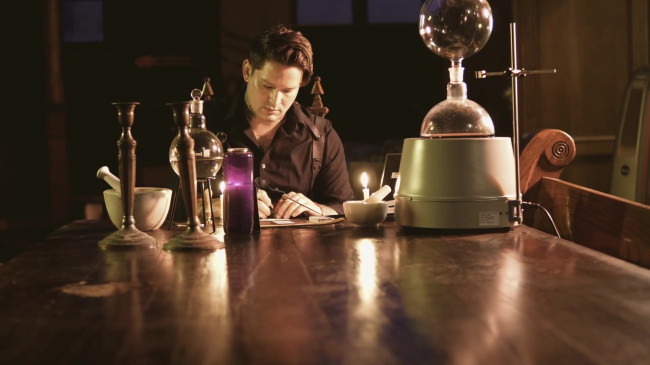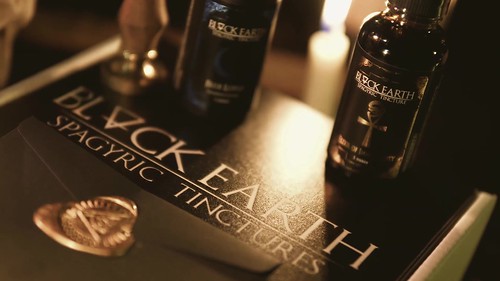A Camp Rattler profile: Guitarist, Black Earth alchemist, and freemason TJ Bell

TJ Bell and I initially met in the winter of 2009 at a tiny “drinkers” bar called Nak’s by the Tracks in Exeter. I had just recently returned to Northeastern Pennsylvania from a New York City burnout and was, at the time, finishing the first draft of a textbook on artist management and development for the Philadelphia Art Institute folks. The guitarist was on furlough from a tour with Scranton metal band Motionless In White. Friends of friends introduced us and we immediately began to drink about “it” straight away. Over the next few years, we had maintained a conversational friendship and, from time to time, grabbed oysters and drinks when we found ourselves in the same zip code.
TJ would look me up at my bar in Pittston, The Rattler, when he was home, or I would visit him and his West Coast tribe when I made it out that way. I had tracked this likable and smart young man’s cool-ass journey from Motionless In White to Escape the Fate, from Exeter Township to Los Angeles, California with the pride of a big brother, even though our friendship was not as such at all. I simply felt happy for this kid from Wyoming Area who had elevated his passion and dreams to that of an international rock star. And, as such, our friendship progressed from that of an industry associate from the hometown sector to that of someone for whom I had grown a genuine respect and fondness.
Sometime after TJ had decided to move back to the East Coast, we had chatted about what was hot and new in each other’s orbit. I was semi-surprised to find out that he had become a freemason while still an LA resident and was curious to see where this path may lead him. Not too very long after that conversation, I began to hear from TJ that he had started the study of the Hermetic arts and was to begin his own experiments into alchemy and magick. I was stoked to hear more and to even assist in any way that was appropriate. A few weeks back, I saw that TJ had begun the retail sales and marketing of his first tincture at The Strange & Unusual in Kingston, owned by his former MIW bandmate Josh Balz. We then approached him with an idea for his product.
A few weeks ago, Camp Rattler had the opportunity to work with TJ on an artistic level, helping to create the video content that would represent one of his two latest endeavors. Black Earth, the brand name of several alchemical tinctures that have been locally handcrafted and recently released in market, is just a glance into the layered diversity that lives within TJ Bell. As a point of reference, he recently hosted the soft release of his signature wine, Alkhemia, at Noir Dark Spirits in Scranton, also a Balz-owned establishment.
We met at Josh’s church in the hill section of Pittston to set up and shoot some scenes documenting TJ’s alchemical processes, equipment, and techniques. As a personal note, local author Mark Stavish was in attendance as resident Hermetic consultant. Kristin Rose and I were thrilled to meet and chat with Mark about all things magickal and supernatural. My associate, Gontay Elgodo of Ghost Eye Films, also a mason, was my chosen DP that evening; it seemed the proper move for the project. A perfectly esoteric cast and crew was on deck for what could only prove to be a wildly interesting, educational, and spirited night of collaboration. We hope that you enjoy the short promo that we have constructed for Black Earth and its herbal spagyrist. Keep your social media eyes open for an upcoming companion piece to Black Earth that will cover TJ’s wine, Alkhemia.
While we were with TJ, we asked a few questions to help the public understand more about Black Earth products and his journey into freemasonry.
CAMP RATTLER: How long have you been a mason? Where did you start?
TJ BELL: Before I had any knowledge of what freemasonry was, I was intrigued by the symbol of the square and compass, which I had first noticed on a ring that a teacher in high school was wearing. The symbolism is what sparked a desire to know what lies behind the mystique of freemasonry. It wasn’t until 2016 that I had actually met and spoke with a freemason.
I was living in North Hollywood at the time, and it was at a Father’s Day dinner when I was introduced to a family friend and master mason called Bill Grey. The topic of freemasonry was brought up at the table, and he could immediately see my interest and curiosity on the subject and ended up connecting me with a lodge that he thought would be a good fit. It was only a week later when he called and told me to check out North Hollywood Lodge No. 542. I showed up at their next stated meeting and met all the guys from the lodge. I was eager to hand in my petition right away but was told to come to the meetings to really get to know the guys and wait about a year before I handed in my petition. I went to every meeting and eventually got to know every member very well. I received my entered apprentice degree June 8, 2017, Fellowcraft degree March 15, 2018, and became a Master Mason May 25, 2018. A year later, I moved back to the East Coast and I received the 32° Master of the Royal Secret on April 13, 2019 at the Valley of Washington of the Southern Jurisdiction Scottish Rite.
RATTLER: How did you become interested in alchemy?
BELL: In the three degrees of blue lodge masonry, information is presented to you, and for those truly interested and listening, there are many wonderful “secrets” built within the framework. Needless to say, I was one of those who wanted to know as much as possible. I wanted to understand the meaning in all of the symbolism. The rituals of freemasonry are layered. As you uncover and understand one layer, there is even more new information that lies underneath, and you continue to discover more and gain new understanding as you go. The words “alchemy” and “Kabbalah” were mentioned a lot in many of the books that I was reading, so that led me into learning about them.
I discovered that what’s called “the penalties” of each degree in freemasonry actually correspond to the three main processes of alchemy (fermentation, distillation, and calcination). This is what left me wondering why alchemy has been hidden within these “secret societies.” Besides the fact that the church persecuted anyone practicing the alchemical arts or members in secret societies, I felt there was more to it than that. That’s when I began actively studying and eventually practicing operative alchemy.
RATTLER: Who are your teachers?
BELL: While in the beginning of my studies, I discovered an alchemist from Taos, New Mexico that was creating medicines from metals. It was when I started taking what’s called the oil of gold, and actively practicing alchemy that I began to notice synchronicities and patterns and it seemed that the universe was literally placing mentors right before me. I borrowed a book from the West Pittston library called “The Path of Alchemy” written by an author by the name of Mark Stavish. Mark is the director of what is called The Institute for Hermetic Studies. The librarian informed me that Mark actually lives just a few miles from where I live! I desperately wanted some guidance on all of this new information, so I figured why not try to get in touch with him and see what happens? I ended up meeting him at a diner soon after, and not only did he become a great friend, but my greatest mentor. I also learned a great deal from other teachers that I had stumbled upon along the way, including Kalin Rogers (Tabū), Robert Bartlett (Spagyricus), and Benjamin Turtle (Temple of Mercury).
RATTLER: How long does it take to create your tinctures?
BELL: Our products are created using the traditional alchemical methodology, which stems from the Hermetic tradition. In alchemy, we are constantly separating, purifying, and recombining while simultaneously working within corresponding planetary days, hours, and certain moon phases, so it can take a great deal of time.
For example, when creating our blue lotus, a lunar herb, we begin at the new moon on a Monday during the lunar hour at sunrise. We then let the herb macerate for an alchemical month, which is about 40 days, and shake it twice a day to pull out its constituents. After that, we separate the spent matter and incinerate it over and over until we get a white ash. This can also take weeks depending on the herb. It’s from these ashes that we obtain the purified mineral salt crystals through washing and evaporating a few times. We then recombine back into the tincture to digest for another week or so. After that, we filter out and throw away the insoluble material, called the caput mortum, meaning “dead head,” and perform a circulation or exaltation for another week. There are many other processes that can be utilized, but this is the process that I typically use, and it took much time, effort, and practice to learn and perfect the process.
RATTLER: Where do you source your ingredients?
BELL: That all depends on which tincture we’re making. We always strive to get the highest quality products possible, always from organic sources.
RATTLER: Can you tell us more about Alkhemia wine? How can it be purchased?
BELL: Black Earth teamed up with the Northeast Pennsylvania Wine Company and have released a flavorful full bodied Tempranillo that comes from Rioja, Spain. Right now, Alkhemia is only available in the state of Pennsylvania and can be special ordered at blackearthalchemy.com. Once you put in your zip code and place your order, it will be delivered to a Fine Wine & Good Spirits in your town and will be ready for pickup.
RATTLER: Where can everyone read more about your products?
BELL: Blackearthalchemy.com.
James Callahan is a 30-year veteran of the music industry, having held positions of A&R, tour management, art/marketing director, creative director, and venue owner. He currently creates visual content with a diverse art collective called Camp Rattler.







